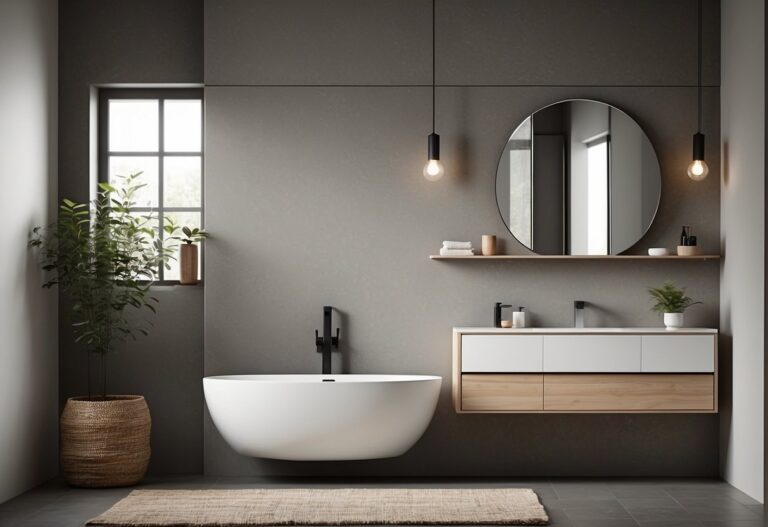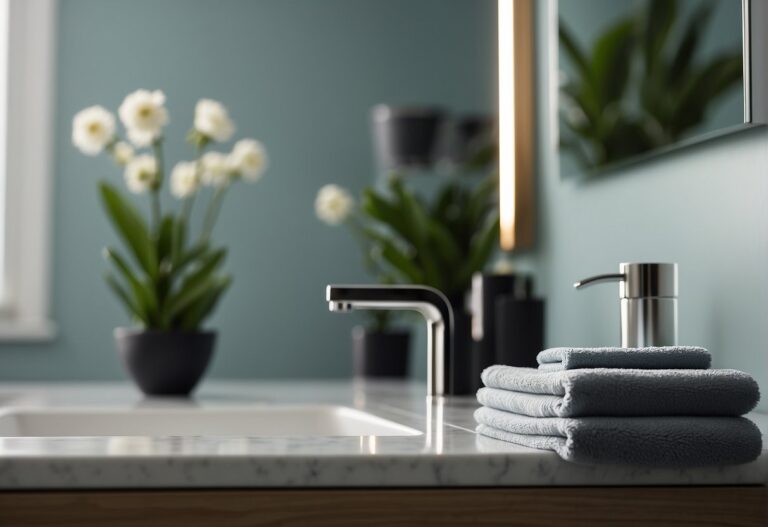Understanding Japanese Minimalism
Discover the art of tranquility with a Japanese Minimalist Bedroom. Transform your space into a serene oasis by embracing simplicity, natural elements, and harmonious design. Uncover the key to creating a calming retreat where less is more, and find inspiration for your journey to a clutter-free and mindful lifestyle.
Japanese minimalism, deeply rooted in simplicity and functionality, has gained popularity as a design style that fosters tranquility and mindfulness. This philosophy, inspired by Zen Buddhism, celebrates the beauty of imperfection and cherishes the simple joys of life. In Japanese culture, minimalism is more than just a design trend; it’s a way of life, reflected in the carefully curated and intentionally small living spaces.
When crafting your Japanese minimalist bedroom, remember these key principles: prioritize natural materials like wood, bamboo, and cotton, embrace clean lines and simple shapes, and cultivate a peaceful ambiance with soft lighting, neutral colors, and natural textures. By adhering to these principles, you can transform your bedroom into a serene sanctuary.
Pro Tip: “Japanese minimalism is not just about aesthetics; it’s a lifestyle that invites calmness and intentionality into your daily routine.”
Key Elements of a Japanese Minimalist Bedroom
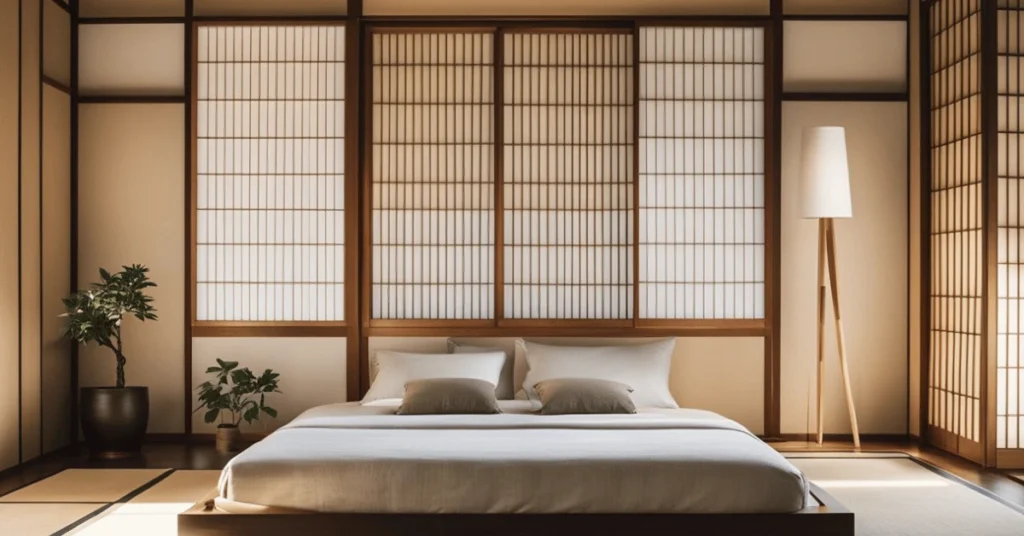
A Japanese minimalist bedroom is characterized by its emphasis on simplicity, harmony, and the use of natural elements. Here are the essential elements that define this style:
Tatami Mats
Tatami mats, made from rice straw and woven rush grass, offer a soft and moisture-regulating flooring option. Often used as a base for futons, they contribute to a cozy and comfortable atmosphere.
Shoji Screens
Shoji screens, crafted from translucent paper and wooden frames, allow soft, diffused natural light to permeate the room while ensuring privacy. They serve both functional and decorative purposes.
Low Furniture
Low-profile furniture, such as futons and floor tables, fosters an open and spacious environment, promoting relaxation and informality.
Natural Materials
Incorporating natural materials like bamboo, cotton, and linen enhances the connection to nature, infusing warmth and texture into the room.
Neutral Colors
A muted color palette consisting of white, beige, and gray creates a serene backdrop, setting the stage for a tranquil atmosphere.
Greenery
Adding small plants like bonsai or succulents brings a touch of nature indoors, enhancing the sense of tranquility.
Expert Insight: “A Japanese minimalist bedroom harmonizes natural elements, clean design, and a peaceful color scheme to create an inviting retreat.”
Choosing the Right Furniture
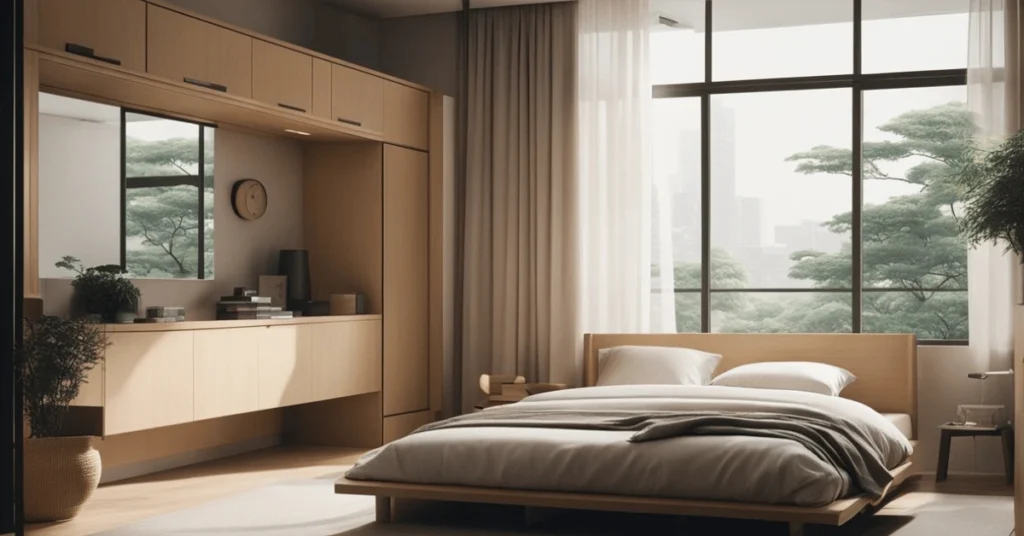
Selecting the appropriate furniture is paramount to achieving the Japanese minimalist aesthetic. Opt for functional, unobtrusive pieces made from natural materials like wood or bamboo.
- Bed frames: Low-profile bed frames create a sense of spaciousness and simplicity. Choose one that complements your bedroom’s overall aesthetic.
- Chairs: Minimalist, low-profile chairs or floor cushions contribute to the room’s open and relaxed atmosphere.
- Dresser: A clutter-free dresser with clean lines preserves the minimalist aesthetic.
- Floor Table: A versatile floor table made from natural materials can serve various purposes, from a workspace to a dining area.
Design Tip: “Choose furniture that blends seamlessly with your bedroom’s design, placing an emphasis on functionality and elegance.”
Incorporating Decor Elements
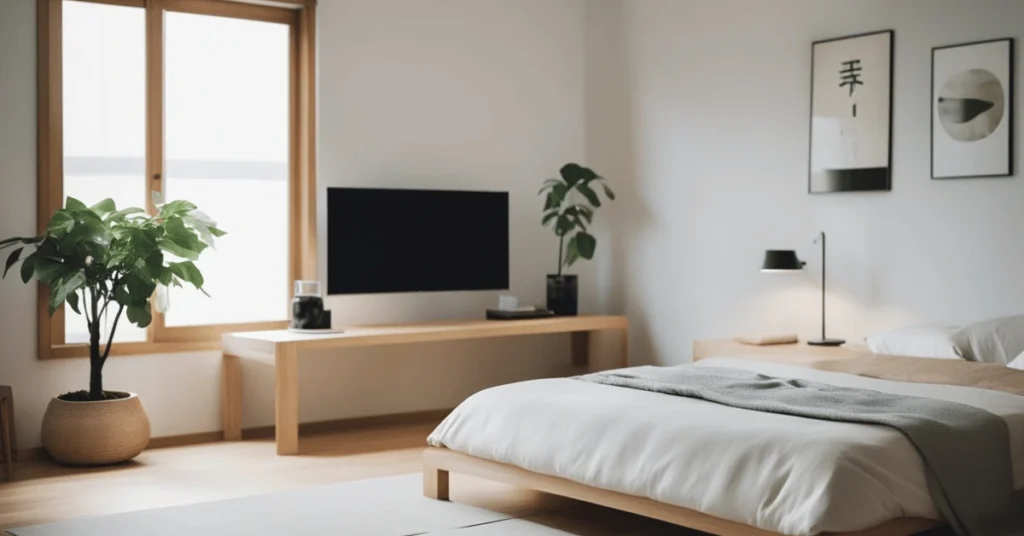
In a Japanese minimalist bedroom, decor elements play a vital role in crafting a tranquil ambiance. Here’s how you can incorporate them effectively:
Bonsai
These miniature trees, steeped in Japanese culture, offer aesthetic appeal and a calming presence. Place them on a shelf or side table to bring nature into your room.
Paintings
Japanese paintings known for their simplicity and elegance can set the tone for your space. Opt for muted colors and natural landscapes or abstract designs that complement your color scheme.
Screens
Shoji screens serve as versatile decor elements that can create room divisions, backdrops for your bed, or cozy reading nooks. They add texture and warmth to your bedroom.
Ambiance
Craft the perfect atmosphere with soft lighting, such as dimmer switches or paper lanterns. Declutter your room and opt for simple, functional furniture. Natural materials like wood and bamboo add warmth.
Decoration
Minimalist decorative elements, such as throw pillows, a cozy blanket, or a single vase with fresh flowers, can introduce color and texture to your room while maintaining the overall aesthetic.
Decor Tip: “Less is more when it comes to decor in a Japanese minimalist bedroom. Choose a few select pieces that align with the room’s aesthetic.”
Selecting the Perfect Color Palette

Choosing the right color palette is essential. Opt for a light and neutral scheme that fosters a calming and serene atmosphere.
- Walls and flooring: White, beige, and gray create a clean, bright look ideal for minimalist bedrooms.
- Natural colors: Infuse shades of green, blue, or brown through bedding, curtains, and decor to connect with nature.
Color Tip: “Maintain a neutral backdrop with subtle hints of color to evoke a sense of calm and serenity.”
Creating Space and Light
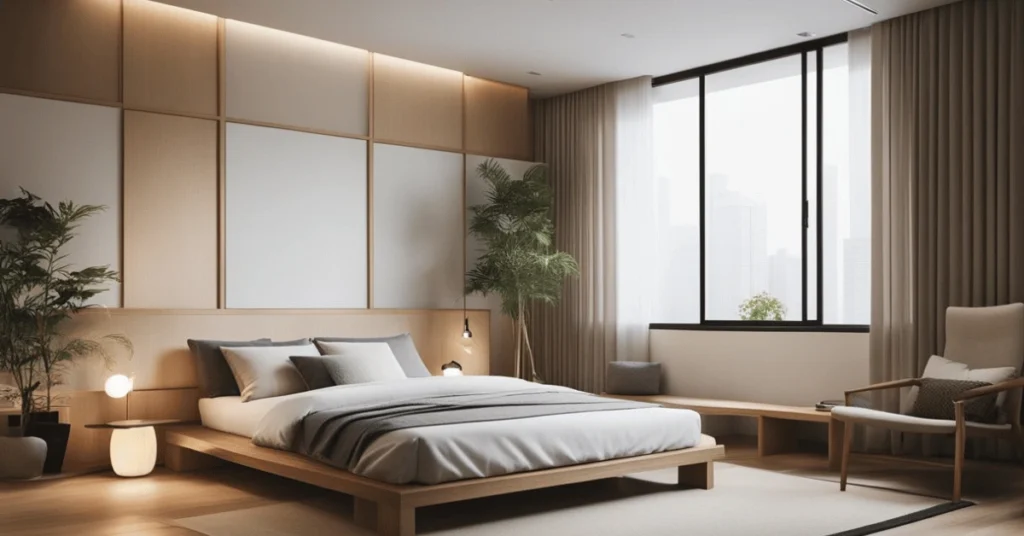
To achieve the essence of a Japanese minimalist bedroom, prioritize space and light. Maximize natural light, eliminate unnecessary clutter, and consider the layout of your room.
- Streamline your room by removing bulky furniture and inefficient storage solutions.
- Enhance natural light with translucent window coverings or even a skylight.
- Opt for soft, warm lighting fixtures to create a cozy ambiance.
- Choose light, neutral colors that reflect light and create an airy atmosphere.
Lighting Tip: “Soft, warm lighting enhances the room’s tranquility, so choose your fixtures carefully.”
Achieving Functionality and Privacy
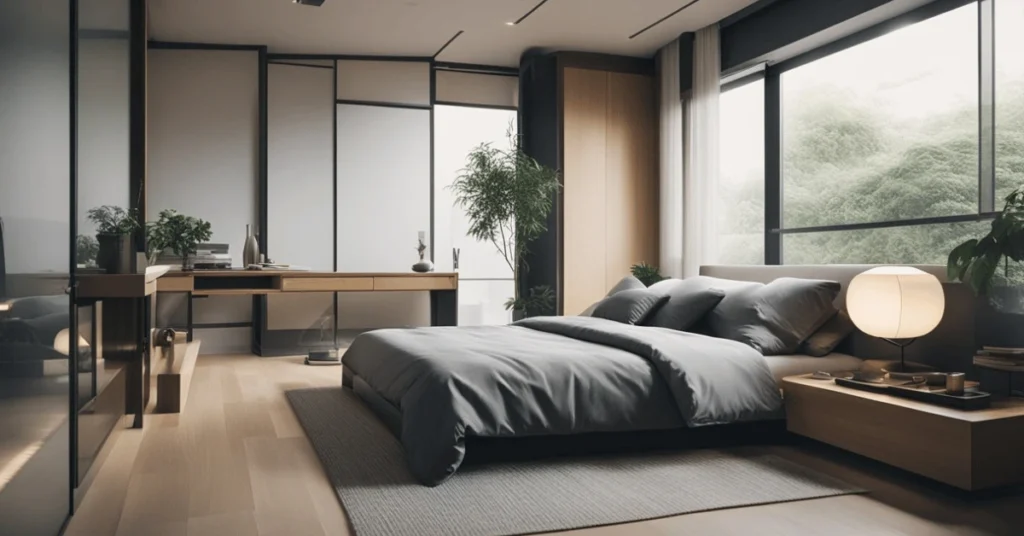
In a Japanese minimalist bedroom, functionality and privacy are paramount. To strike the right balance, consider these tips:
- Keep it Simple: Avoid clutter by sticking to the essentials and choosing practical, aesthetically pleasing furniture.
- Create Storage Space: Use smart storage solutions like wall-mounted shelves, under-bed storage, and built-in cabinets.
- Use Privacy Screens: Incorporate screens to divide areas, add privacy, or create cozy nooks.
- Incorporate Natural Elements: Introduce wood, bamboo, or plants to enhance tranquility and warmth.
Privacy Tip: “Privacy screens are stylish and versatile additions that can enhance both privacy and aesthetics.”
Designing a Tranquil Environment
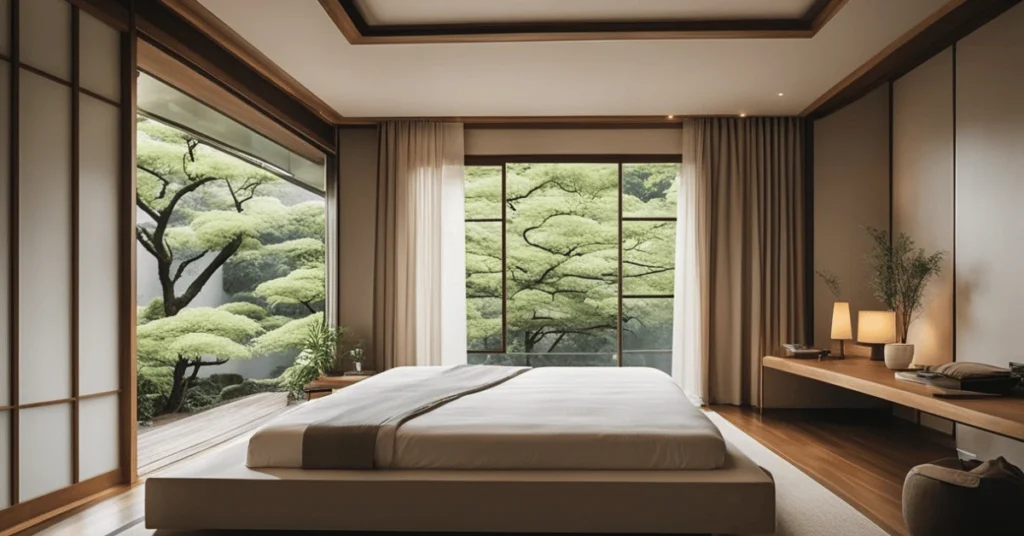
Designing a Japanese minimalist bedroom requires careful consideration to achieve a tranquil environment. Here are tips to help you create a serene and peaceful space:
- Embrace Minimalism: Prioritize simplicity and declutter your space, allowing only necessary and joyful items.
- Incorporate Natural Elements: Use wood, bamboo, and cotton for furniture and decor to connect with nature.
- Use Soft Lighting: Opt for gentle, warm lighting to establish a soothing atmosphere.
- Keep Colors Neutral: Stick to neutral tones for walls and furniture, reserving pops of color for accents.
- Focus on Comfort: Invest in a quality mattress, soft rugs, and comfortable seating to ensure restful nights and relaxation.
Tranquility Tip: “A Japanese minimalist bedroom combines simplicity with comfort to create an inviting oasis.”
Modern Japanese Bedroom Ideas
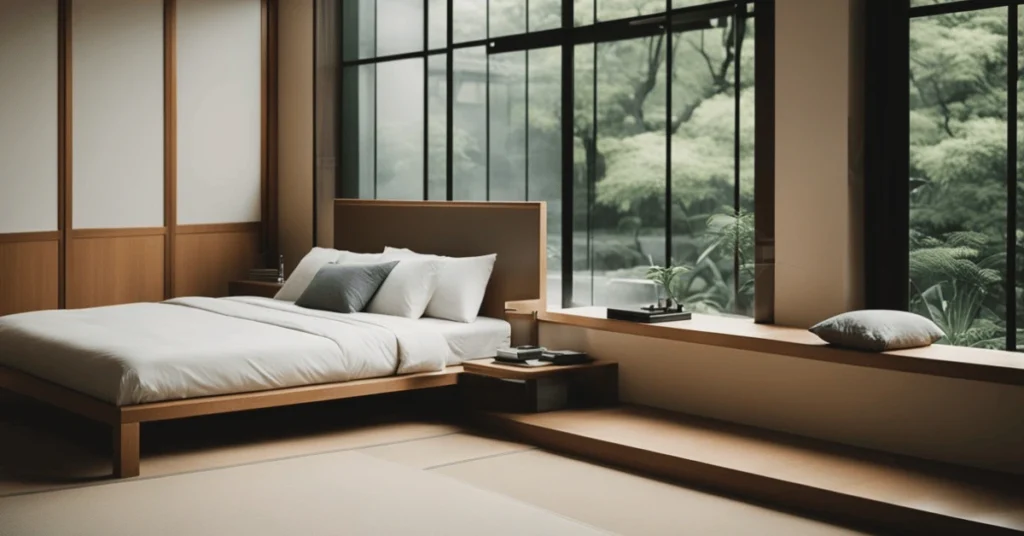
It is the blend of a minimalist design, natural materials, and a neutral color palette which makes a modern Japanese bedroom special. Key elements include platform or raised beds, multi-functional furniture, and a serene color scheme:
- Platform Beds: Low-profile beds made of wood or bamboo are common, evoking the traditional Tatami theme.
- Multi-Functional Furniture: Consider minimalist bedside tables, floor sitting tables, and space partitions.
- Color Palette: Embrace neutral colors like white, beige, and gray for a calming atmosphere.
- Textiles: Use natural fabrics like cotton, linen, and wool for throws, pillows, and benches.
Modern Tip: “Modern Japanese bedrooms blend tradition with contemporary elegance, offering functional simplicity.”
Japanese Minimalist Bedroom Layouts
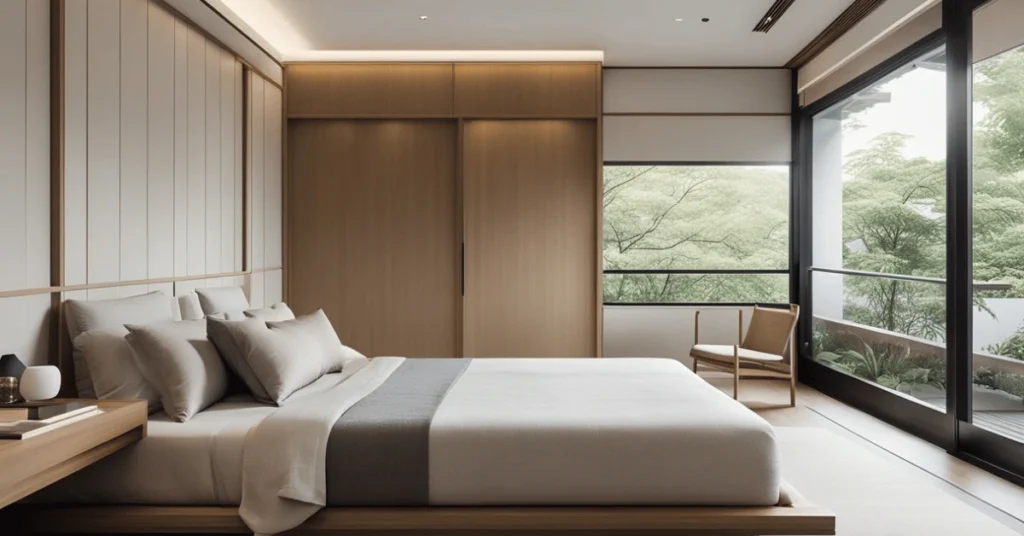
Designing the layout of your Japanese minimalist bedroom is crucial for creating an atmosphere of calm and maximizing space utilization. Follow these layout tips:
- Bed Placement: Position your bed in the center or against a wall, with a low headboard for openness.
- Furniture Arrangement: Keep furniture minimal and strategically arranged for ease of movement.
- Color Scheme: Stick to a calming color palette of whites, beige, and gray for walls and bedding.
- Lighting: Use a mix of overhead and floor lamps with soft, warm light to set the mood.
- Flooring: Consider hardwood or bamboo flooring with a small area rug for added warmth.
Layout Tip: “A harmonious layout ensures an uncluttered and peaceful space in your bedroom.”
Tips for a Japanese Minimalist Bedroom
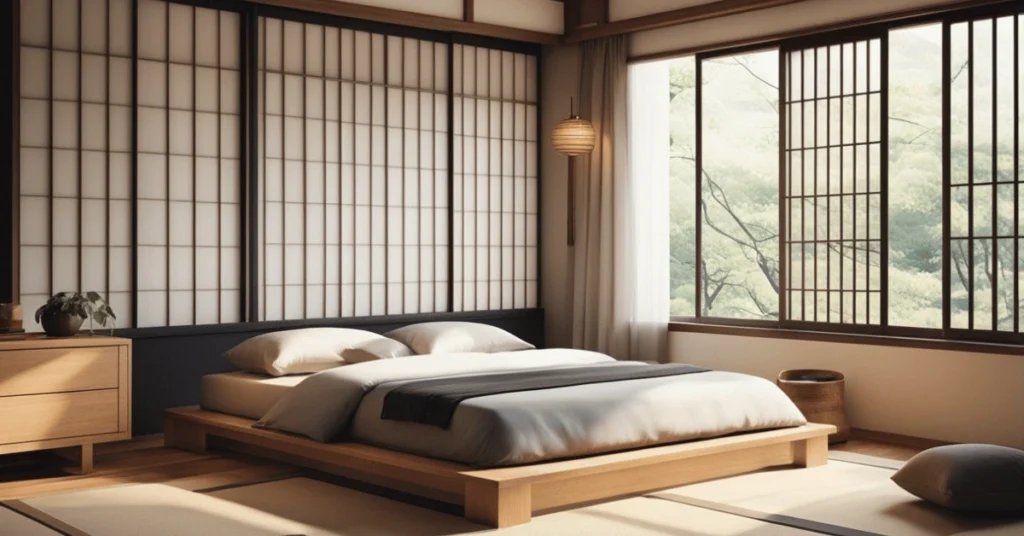
In essence, to create an inviting and calming Japanese minimalist bedroom, remember these key factors:
- Less is More: Prioritize simplicity and eliminate clutter.
- Natural Materials: Use wood, bamboo, and other natural materials.
- Lighting: Choose soft, warm lighting for a relaxing ambiance.
- Storage: Implement efficient storage solutions.
- Color Palette: Opt for a calming and neutral color scheme.
- Nature-Inspired Decor: Integrate natural elements into your decor for tranquility.
Top Tip: “Simplicity, nature, and mindful design are the cornerstones of a Japanese minimalist bedroom.”
FAQ
What is a Japanese minimalist bedroom?
A Japanese minimalist bedroom is a tranquil and uncluttered space inspired by Japanese design principles, emphasizing simplicity, natural materials, and harmony.
How to decorate a Japanese minimalist bedroom?
Decorate with natural materials, neutral colors, and minimal furniture. Use shoji screens, tatami mats, and simple decor elements for an authentic look.
What are the key elements of Japanese minimalist bedroom design?
Key elements include tatami mats, shoji screens, low furniture, natural materials, neutral colors, and greenery.
Where can I find Japanese minimalist bedroom furniture?
Look for Japanese-style furniture at local stores specializing in home decor or online retailers that offer authentic or inspired pieces.
What color palette is ideal for a Japanese minimalist bedroom?
Stick to neutral colors like white, beige, and gray, with occasional muted accents for a calming and serene atmosphere.
How to create a sense of space and light in a Japanese minimalist bedroom?
Maximize natural light, use soft and warm lighting, choose light-colored walls, and minimize clutter for an open and airy feel.
What’s the ideal layout for a Japanese minimalist bedroom?
Prioritize simplicity, place the bed strategically, arrange furniture for good flow, maintain a calm color scheme, and consider the lighting.
How can I achieve functionality and privacy in a Japanese minimalist bedroom?
Keep it simple, use smart storage solutions, employ privacy screens, and incorporate natural elements for a functional and private space.
We’ve delved into the art of crafting a serene Japanese minimalist bedroom, but we’re eager to hear from you!
Have you implemented any of these design elements in your own space?
Do you have additional ideas or experiences to share? Your insights and personal touches can inspire others. Join the conversation by leaving your comments below!




